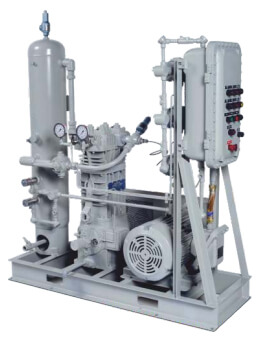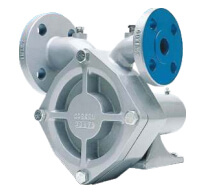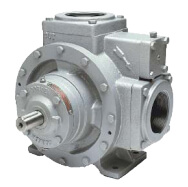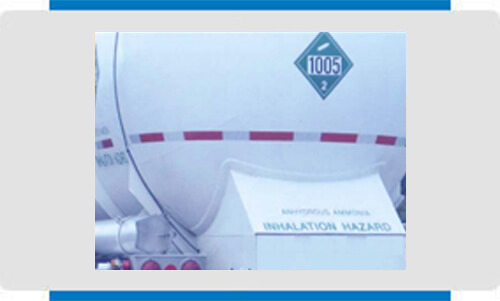Challenges in Handling Anhydrous Ammonia Gas
Anhydrous Ammonia has a very characteristic odor and the odor is the strongest safety feature of the product and Larger concentration may result in health (suffocation) and safety hazards. So, leakage control becomes an important feature for any equipment handling ammonia gas. Minimization / elimination of impurities like oil, moisture, etc. is an inherent demand of Anhydrous Ammonia at industrial level applications. Typically, Anhydrous Ammonia at plant level is stored under pressure in bullets or spheres (designed at about 310 psi(g) at 55’C ) which makes it a moderately high-pressure application for any storage and transfer equipment. Anhydrous Ammonia use, depending on its location on the process map, may require the smallest of capacity (like unloading or tanker mounted applications) or may demand higher capacity if used for plant process applications. Material of Construction suitable for Anhydrous Ammonia with other gas mixtures in the stream mainly for critical process applications. Safety regulations dictate storage yards to be at a distance from the plant. Hence, for such locations, equipment not requiring water supply (Air Cooled), Energy Efficient (Lower Power Consumption), less frequent maintenance (Longer Running Life of Parts) and lower downtimes (Maintenance-Friendly) become decision influencers and are always a thumbs-up for any user.How our unique offerings combat these challenges for users?
- Greater control of fugitive emissions by offering compressors with packing sets designed for precise leakage control.
- Oil-free gas compression by effectively separating the oil chamber from the gas compression chamber with non- lubricated wetted parts. Use of skid accessories protecting compressor from harmful carryover entrants such as moisture, condensates, impurities.
- Wide Pressure Rating range available with Models offering from design pressure of 23.1 Bar (g) up to design for 113 Bar (g)
- Capacity Options available…. Smaller vertical machines to larger horizontals, VFD for varying RPM’s along with suction uploaders for capacity control with single- or two-stage in single- and double-acting designs.
- Material options to meet the demands of volatile and toxic gases with wide range of materials for compressor parts, gaskets and O-rings, protective coatings.
- Minimum TCO with User Friendly Design. Products designed keeping in mind to keep customer’s Total Cost of Ownership lower combined with simple break-and –build model for ease of operation and maintenance, easy parts replacement and interchangeability for making users comfortable and confident to handle machines.
Any process involving transfer of Anhydrous Ammonia Gas would require a compressor or a pump and CORKEN offers both solutions suiting your needs for hassle-free NH3 transfer. Anhydrous Ammonia is typically boiling liquid (Gas stored under vapor pressure) and is most popularly transferred in bulk via Road Tankers to users who unload these tankers into their storages using CORKEN Air Cooled and Non lubricated reciprocating Compressors.
CORKEN’s Reciprocating Gas Compressors
 (following general compliance to API 618 guidelines with accepted deviations), along with ourpre-engineered mountings are used for:
(following general compliance to API 618 guidelines with accepted deviations), along with ourpre-engineered mountings are used for:
- a) Both Liquid Transfer and VaporRecovery of ammonia from railcars ortrucks to storage facilities. Aunique process where the compressoris used to create a pressure differential between the storage facility and the railcar. The liquid product will then flow in the direction oflesser pressure, i.e. from the railcar to the storage facility through a separate liquid line between the two tanks. The vaporleft in the tanker / rail caris then recovered using the same compressor.The same principle is also used at Ammonia Manufacturing / reselling plants from loading tankers / rail cars.
- b) Storage Decommissioning – As per safety guidelines globally, storage vessels are periodically tested (NDT process like Hydrotesting, etc.) for ensuring operational integrity from safety standpoint with respect to leaks and cracks. CORKEN compressors are used for transferring liquid and gas to another storage to avoid gas loss using the same principle as tanker / rail car unloading.
- c) Process Gas Applications. Applications involving Ammonia Gas mixtures in chemical – chemical ntermediate plants for manufacturing of Ammonia derivates, where compressors are used for Pressurized Gas Boosting into Reactions along with reactor Residual Gas Recycling – boosting and recovery forgas components by further scrubbing orcolumnized condensation, Boil Off Gas Compression
CORKEN’s Pump offering include:

Coro Vane Series – Positive Displacement Sliding Vane Pumps – used for bulk transfer of NH3. Applications like Tanker unloading (where only liquid transferis envisaged and no vaporrecovery is envisaged), Tank to Tank Bulk liquid
transferinvolving largerflows but smallerdifferential pressures.

Coro flo Series – Dynamic Regenerative Turbine Pumps – used for pressurized transfer of NH3. Applications like cylinder filling (one of the methods for Ammonia transferfor smaller users), Tank to Tank / Reactorliquid transfer / injection involving medium to high differential pressures and smallerflows.

Gas Properties
UN1005 class 2.3 Boiling Point: −33.34 °C (−28.01 °F; 239.81 K) Critical Temperature: 132.4 °C (405.5 K) Critical Pressure: 111.3 atm (11,280 kPa or 1636 psia) Vapor pressure: 212 PSIA @ 100°F Ratio of Specific Heats (Cp/Cv), n = 1.31Production
The Haber process, also called the Haber–Bosch process (It is named after its inventors, the German chemists Fritz Haber and Carl Bosch), is an artificial nitrogen fixation process and is the main industrial procedure to produce ammonia.Description
Ammonia is a colorless gas with a characteristic, pungent odor, which humans can detect at 5 parts per million. Ammonia is naturally found as a minute proportion of the atmosphere and is the product of decomposition of animal and vegetable matter as well as in volcanic gases. Commercially, the major method of ammonia production is the Haber method, which combines nitrogen and hydrogen at high temperatures and pressures in the presence of a catalyst. To know more about Anhydrous Ammonia, kindly refer below typical examples where it is used…..Description
Ammonia is a colorless gas with a characteristic, pungent odor, which humans can detect at 5 parts per million. Ammonia is naturally found as a minute proportion of the atmosphere and is the product of decomposition of animal and vegetable matter as well as in volcanic gases. Commercially, the major method of ammonia production is the Haber method, which combines nitrogen and hydrogen at high temperatures and pressures in the presence of a catalyst. To know more about Anhydrous Ammonia, kindly refer below typical examples where it is used…..Typical Use – Markets and Industries Served
Used as Nitrogenous Fertilizers including manufacturing of other nitrogen-based fertilizers such as Urea carbamide), Ammonium Sulphate (Diazonium sulfate), etc. Refrigerant (R717) – very efficient refrigerant with zero Global Warming Potential (GWP). used in low and medium temperature refrigeration such as Selective Catalytic Reduction (SCR) a) Nitrous Oxide (NOx) in flue gas emissions (e.g., pollutants emitted by diesel engines) b) Ammonia is used to scrub SO2 from the burning of fossil fuels, and the resulting product is converted to ammonium sulfate for use as fertilizer Metal processing a) Ammonia Cracking for Hydrogen Production used as reducing agent for Heat treatment for Annealing furnaces for CR Steel. b) Ammonia is used as nitrogen donor for metal nitriding process. Nitrogen atoms diffuse into steel, producing hardened, corrosion-resistant surface layer. Plasma Etching (Etching gas) in semiconductor manufacturing Used as Precursor / Raw Material for many chemicals such as- a) Amines – Amines and Amines derivatives are used widely in the API Pharma industry as drug manufacturing intermediates.
- b) Nitric Acid – which is used to produce fertilizers, explosives, and many organonitrogen compounds.
- c) Household Ammonia – most common uses is to clean glass, porcelain and stainless steel.
- d) Manufacturing of Quaternary ammonium compounds (QACs) – popularly known as Benzalkonium Chlorides (BACs) – which were also popular during COVID-19 for disinfecting Food Contact Surfaces (guidelines issued by FSSAI).
